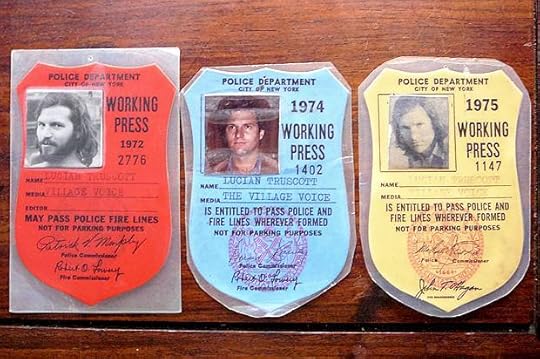Helen H. Moore's Blog, page 315
August 31, 2017
David Clarke has resigned as Milwaukee County Sheriff, clerk says

David Clarke, Sheriff of Milwaukee County, Wis., speaks during the opening day of the Republican National Convention in Cleveland, Monday, July 18, 2016. (AP Photo/J. Scott Applewhite) (Credit: AP)
On Thursday afternoon, David Clarke resigned as the sheriff of Milwaukee County, Wisconsin.
The resignation was turned in to Milwaukee County Clerk George L. Christenson at 3:16 p.m. local time, according to BuzzFeed News.
Clarke was an early and outspoken supporter of President Donald Trump, and at one point he looked poised to join the administration: Clarke announced on a radio program in May that he was offered a position as an assistant secretary in the Department of Homeland Security (DHS), BuzzFeed reported. Clarke ultimately rescinded his name as a potential candidate. However, DHS officials have said that Clarke was never offered any job.
Clarke, whose authoritarian positions put him in the same ideological camp as Maricopa County, Arizona’s disgraced ex-sheriff Joe Arpaio, has a long and controversial history of abuse of power. Clarke was an outspoken provocateur that vociferously defended law enforcement, even in the face of opaque police misconduct.
A former Milwaukee County inmate was recently awarded $6.7 million after she claimed she was repeatedly raped by a guard and, later, shackled to her hospital bed during childbirth — an incident that occurred during Clarke’s reign as sheriff. (Similarly, Sheriff Arpaio reportedly forced imprisoned women to give birth in shackles in Maricopa County.)
Allegations of abuse of power cloud Clarke’s career. Four Milwaukee County inmates died over a six-month span under the former sheriff’s watch.
In another alarming incident, Clarke was on a commercial flight when a fellow passenger asked if he was in fact the well-known sheriff; Clarke had him detained after the plane landed. During the flight, Clarke wasn’t wearing his usual outfit, a military uniform adorned with assorted medals — medals which one army veteran pointed out violated military uniform code, and included many “novelty pins.”
Clarke has blasted the Black Lives Matter movement and claimed that they are responsible for creating a culture of violence and poverty in black communities.
CBS reported that Clarke’s resignation letter did not contain a reason for his departure from the department. It’s not currently clear if he will seek a job with the Trump administration in the future.
Is ageism the last acceptable prejudice?

Ashton Applewhite speaks at TED2017 - The Future You, April 24-28, 2017, Vancouver, BC, Canada. (Credit: Bret Hartman/TED)
Ten years ago, when she was in her mid-fifties, Ashton Applewhite, like many of us, resisted the idea of getting older. Everything she’d thought about old age she’d learned from movies, TV and ads that sell products on the premise that aging is a problem to be solved — like with the right anti-wrinkle cream or medication, you can overcome it and somehow stop time.
In my conversation with Applewhite on “Inflection Point,” she observed, “People can’t make money off satisfaction. So there’s a lot of market forces framing aging as a problem or disease when it is neither. It is a natural, powerful, life long process that we all share, and that should unite us, not divide us.”
It’s good to remind ourselves that in a divided world, at least there’s one thing we all have in common: we’re getting older — and hopefully wiser — with every moment we live. It wasn’t until Applewhite had the opportunity to learn what life was actually like from people in their eighties that she realized everything she’d thought about aging was wrong.
What she discovered inspired her not only to learn more about the real, true aging process, but also to quit her job — not retire — and focus all of her energy on being an activist to lead the fight against what she calls “the last acceptable prejudice.” According to her, that’s ageism.
Applewhite published a manifesto against ageism called “This Chair Rocks,” and she gave a TED Talk this August called “Let’s end ageism.” At the end, she received a standing ovation. She’s onto something.
What does ageism look like? And if we see it through Applewhite’s lens, how can we stop trying to stop getting old and start embracing it as an amazing part of the human condition?
Listen to my conversation with ageism activist Ashton Applewhite here:
Penn State professors get $300,000 to create fake-news detector

A pair of professors from Penn State University received a $300,000 grant in an effort to help produce technology — specifically “devices” — that would be able to efficiently detect fake news, according to the Associated Press.
The National Science Foundation awarded the grant to sciences and technology professor Dongwon Lee and communications professor S. Shyam Sundar, both of Penn State. Lee told the AP that “fake news has been around for decades” but has since “exacerbated” due to careless sharing on social media and widespread use of the internet.
Lee explained to Salon that “when you look at the contents of the fake new article, or the surroundings; which website it comes from, or what kind of styles or linguistic patterns it might have . . . there might be some hidden pattern that distinguishes the legitimate article from the fake news article.”
“Using the motioning technique we try to pick up that pattern,” Lee said. He explained that, for all the good will around the project, this technology is still at a hypothetical stage, so he’s unsure if he and Sundar will able to distinguish such a pattern or not. He adds, however, that “if we do then, using that pattern we can build some kind of model that in the future can tell if the news article is fake or not.”
Lee reiterated that fake news “has been around for many, many years” and only recently became a major issue because “the virality of the fake news is so much faster.” He added that people “blindly retweet” and share on social media “without checking the validity” of an article.
He used Facebook as an example explaining that, while the company uses third-party fact checkers, such methods make response times slow and allow the false information to disseminate before human invention can stop its spread. Lee holds that machine-based solutions will improve such search and interdiction efforts on Facebook and various other social-media platforms.
Again, this technology is barely in its infancy, so, until further notice, please continue to use your brain when reading, hearing or talking. Ever vigilant, friends. Ever vigilant.
Fox News poll: 56 percent say Trump is “tearing the country apart”

(Credit: Getty/Drew Angerer)
According to a new poll released by Fox News — normally a cheerleader for President Donald Trump — 56 percent of voters believe that the current commander-in-chief is “tearing the country apart.” The poll by the conservative news network also found that just 33 percent of voters said the president is “drawing the country together.”
The president’s approval rating, 41 percent, stayed the same as a Fox New poll conducted in July, but his disapproval rating went up from 53 percent to 55 percent. The poll was conducted between August 27 and 29.
Overall, voters polled by Fox News are expressing disapproval over various issues on Trump’s agenda, including some of his so-called “America First” policies. For example, on immigration, 54 percent of voters said they disapprove of the way the president has handled the issue, while only 43 percent said that they approved. On subjects including North Korea (43-50), the environment (36-56), Russia (35-56), health care (34-60) and race relations (33-61), more voters disapproved of the president’s actions than approved.
A majority of voters also disapproved on tax reform (37-45); however, it also had the highest percentage of “don’t know” answers, 18 percent, which could be due to the fact that very little is currently known about Trump’s tax reform plans.
Trump did, however, receive a majority approval rating on issues such as the economy (49-43) and terrorism (47-45). He broke even on the war in Afghanistan at 43 percent either approving or disapproving and 15 percent saying they didn’t have an opinion.
Fifty-six percent of voters also said that they believe Trump doesn’t respect racial minorities, while only 41 percent said that he does. Regarding the recent incidents in Charlottesville, 52 percent of voters said they believed white supremacists were responsible for violence, which is in contrast to the president’s response.
While Trump continues to promise a wall along the U.S.-Mexico border, voters don’t appear to actually want it. Fifty-six percent of those polled by Fox News opposed building of a wall, while only 39 percent favored it.
To be somewhat fair, Trump isn’t the only one with poor ratings. As whole, Congress fairs far worse, with a stunning 74 percent disapproval rating. Only a minute 15 percent of voters approved of their job performance.
Chances of Trump impeachment at high point

(Credit: AP/J. Scott Applewhite)
While Houston drowns and North Korea provokes, the case for the impeachment of President Trump is growing stronger. The news of Hurricane Harvey’s destruction and Kim Jong Un’s latest missile test has obscured a series of unrebutted revelations that strengthen the already sturdy case that the president has obstructed the FBI investigation into the ties between his campaign and the Russian government.
The revelations shed new light on both the chummy ties between the Trump campaign and the Russian government and on Trump’s recent efforts to hinder the investigation of special prosecutor Robert Mueller.
Not only did Trump’s business associates appeal to Russian officials in late 2015and early 2016 for help in building a Trump Tower in Moscow, but Trump also personally called Sen. Thom Tillis R-N.C. in early August to denounce his legislation to protect Mueller from being fired.
In a July 20 interview with the New York Times, Trump said any investigation of his family business in connection with the Russia investigation would be a “violation” of Mueller’s responsibilities and grounds for his dismissal. Mueller, it is now clear, has called Trump’s bluff. He is delving deeply into Trump’s real estate dealings and how they relate to Russia’s efforts to influence the 2016 election.
So are congressional investigators. The Times reported Monday that the Trump Organization turned over emails related to the proposed Trump Tower deal to the House Intelligence Committee, which is also investigating Russian meddling in the presidential election.
‘Someone who knows how to deal’
The Post reported that Michael Cohen, one of Trump’s closest business advisers, asked longtime Putin lieutenant Dmitry Peskov for help in “the development of a Trump Tower-Moscow project in Moscow City.”
“As this project is too important, I am hereby requesting your assistance,” Cohen wrote. “I respectfully request someone, preferably you, contact me so that I might discuss the specifics as well as arranging meetings with the appropriate individuals.“
Cohen’s email, the Post noted, “marks the most direct outreach documented by a top Trump aide to a similarly senior member of Putin’s government.” The deal never came to fruition.
Cohen said in a statement to Congress that he wrote the email at the recommendation of Felix Sater, a Russian American businessman who was serving as a broker on the deal. The Times reported that Sater had boasted the deal could help elect Trump, which may have been the sort of hype that routinely lubricates real estate deals.
But Sater’s email to Cohen, published by the Times, voiced hope for a relationship that would go beyond real estate.
“Michael we can own this story,” Sater wrote. “Donald doesn’t stare down, he negotiates and understands the economic issues and Putin only want to deal with a pragmatic leader, and a successful businessman is a good candidate for someone who knows how to negotiate. ‘Business, politics, whatever it all is the same for someone who knows how to deal’ . . . ”
Mueller’s strategy
The question of how Trump sought to deal with Russia is at the heart of Mueller’s investigation.
The proposal for a Trump Tower in Moscow was just another manifestation of Trump’s long-standing desire to build in Russia. In 2013, he signed a preliminary agreement to build a hotel in Russia in partnership with Aras Agalarov, a billionaire who had financed the Trump-owned Miss Universe pageant in 2013.
A representative of Agalarov’s company attended a June 2016 meeting with top Trump aides and a Russian lawyer organized by Donald Trump Jr. The lawyer offered to provide damaging information about Hillary Clinton collected by the Russian government. The meeting was “part of Russia and its government’s support for Mr. Trump,” according to an email made public by Don Jr.
Six days later, a person identifying himself as “Guccifer 2.0″ released a Democratic National Committee file on Trump, stolen from the DNC computers. It was the first in a flood of leaks harmful to Clinton that would continue for the rest of the campaign.
According to an NBC News report Monday, Mueller’s team of prosecutors are focusing on Trump’s role in drafting a public statement claiming the subject of the meeting was the adoption of Russian orphans by Americans.
A source “familiar with Mueller’s strategy” told NBC that whether or not Trump made a “knowingly false statement” is now of interest to prosecutors.
Even if Trump is not charged with a crime as a result of the statement, it could be useful to Mueller’s team to show Trump’s conduct to a jury that may be considering other charges.
The revelations show the president and the independent counsel are on a collision course that can only end in a constitutional crisis and impeachment proceedings.
The threat to bring Trump’s conduct to a jury is a threat to Trump’s family and his presidency. Trump’s pardon of Arizona sheriff Joe Arpaio, convicted of contempt of court for disobeying a court order to cease the profiling of Latinos, shows he believes his political whims take precedence over the workings of the law.
Trump has spoken privately about firing Mueller, only to be talked out of it by aides. Senate Minority Leader Chuck Schumer has said Mueller’s dismissal would be a “tipping point” for Senate Republicans. Sen. Lindsey Graham has said firing Mueller would be “the beginning of the end” of the Trump presidency.
The tipping point is drawing closer.
The space Trump fills in America’s racial politics

(Credit: AP/Susan Walsh)
Donald Trump has now gone beyond the limits that he had reached which were already outrageous enough. By being even-handed between the Extreme Right and their civil society resisters, he has breached all norms.
His attempts to track back were not sincere. His heart is really on the side of the White Nationalists and their even more bizarre partners.
The question is: Why has he done this? Most people think Donald Trump is stupid and/or evil. But that is what his detractors have thought ever since he entered the Presidential race. Despite all the opposition and ridicule, he won.
This allows an alternative interpretation for his behavior — one that some (or many) may find deplorable, but need to reflect on nevertheless.
Whether or not Trump is a very rational, calculating person, he has seen through the agreed stance of the two major parties.
He has found chinks in the armor of the liberal order — a point where neither party will stand officially but enough voters will back him anyway — and wants to exploit (that is, pierce) it.
The right exploit
Like many previous Rightist movements have realized, shock tactics have the value of outraging the majority and exposing vulnerabilities in the cross-party dominant order. These weaknesses can be exploited in their favor.
But the outrage also encourages a far-right movement’s own supporters, who get treated like pariahs, that someone is speaking for them when the major factions refuse to.
The danger with Trump is that people underestimate him as an ideological politician.
Take the present instance, as neo-Confederates mass in the streets to protest the removal of 20th century monuments to their 19th century secessionist heroes.
The American Civil War has elicited a massive literature of interpretations over the last 150 years. The simple liberal formulation would be that Lincoln fought for the abolition of slavery and the North defeated the South and also White nationalism.
The great historical revisions
But think again. When I had just come to the United States as a young 21-year-old in the early 1960s, I recall seeing the front-page of the Book Review section of the Sunday edition of the New York Times. It had the headline Who Won the Civil War?
The review article covered recent books on the Civil War, which were revisionist in their reading of the war. The win-loss outcome of the war itself was not the issue. It was about undermining all the narratives around the causes and aftermath.
The South had its defenders, and revisionist historians — moving beyond even their Lost Cause predecessors — had found chinks in the armor of the mythology around Lincoln himself.
This was 55 years ago. I soon learned that Lincoln avoided bringing in the Slavery issue as long as he could. The war, we were now to believe, was about saving the Union not about emancipating the Slaves.
(Even today, no amount of 1861 documents identifying the Secessionist cause as slavery will convince many Americans otherwise.)
Altered narratives
I also soon found out that politicians speaking from the podium would call it “The War between the States,” not The Civil War.
The heroes of the Civil War apart from Lincoln were increasingly, in the narrative, Southerners. Confederate General Robert E. Lee and his fellow officers, much more than Confederate President Jefferson Davis.
There was better press for Lee — a brutal slaveholder — than for Grant, the exceptional northern commander who eventually defeated Lee.
The histories that I read in the early Sixties were by White historians writing about the War between two sides of the American White family. That is particularly remarkable since, in historical fact, so many poor Southerners had fought for the Union and resisted the Confederacy from within.
Later, after the Civil Rights movement took off, there was some correction back to reality, but by and large the role of Black soldiers was painted as marginal and exotic.
The Civil Rights movement
The Sixties also saw the first attempt in a hundred years to finish the unresolved problems of the emancipation of slavery and the unfinished post-war Reconstruction that was supposed to implement rights of former slaves.
The struggle to put Black Americans on a footing of equality in terms of their political rights resumed.
It is forgotten now that John Kennedy was a reluctant reformer. His father had friends among the powerful Dixie democrats, such as Senator Strom Thurmond, who had delivered the Southern Democratic votes for his son.
Lyndon Johnson, the accidental President from Texas, fought the hard battle for Civil Rights after Kennedy’s death and delivered.
Even then, only the most surface rights and rollback of statutory apartheid were secured. There has not been another effort to complete that program in the nearly fifty years since Martin Luther King Jr.’s assassination.
Subtler forms of pernicious discrimination, de facto segregation and poor human development outcomes continue for African-Americans.
Back to the future
Mainstream politicians denounced Trump for his endorsement of the White Nationalists after the attack in Charlottesville. Corporate leaders covered themselves by an open declaration of protest against Trump’s endorsement of racism.
They should instead declare what they have done to improve the condition of their Black employees (if they have any!).
All these years, politicians have tolerated the precarious voting rights for Black Americans in many states. The lives of Black men, young and old, remain liable to be ended by the forces of Law and Order. The bulk of Black Americans suffer from serious economic and social deprivation.
Choosing a Black President warmed millions of hearts but did not materially change the Black condition.
Economic stagnation, race relations stagnation
The reason for this non-action was obvious. Popular support for Black Rights was weak in the majority community. The affluent White middle class was relatively accepting at first, when the economy was prospering in the 1960s.
But since the stagflation of the Seventies and the decline in manufacturing jobs and wages, there has been no effort at mobilizing White support for Civil Rights.
As they say in India, “a creamy layer” of Black Americans has benefited, leaving the bulk behind.
Even this small change has roused White envy. No one in the mainstream openly talks about it. In the early Obama years, the Tea Party mobilized this resentment with a more veiled call to “take back our country.”
Now it is simply unmasked in the other emerging groups, who enthusiastically backed Trump on the basis of his decades of racist antagonism.
Neither party will act
The Republican Party does not disavow the support it has gotten from White resentment from 1964 to present. It merely wishes they would keep it implicit, not explicit.
The Democratic Party shies away from a radical commitment to finish what Lyndon Johnson began, even as it costs them elections through racist voter suppression. Their rhetoric is readily anti-racist. It is openly asserted that White Nationalism is unacceptable.
But there is no passion in either party for resuming the struggle for racial equality. The votes of the majority community — Nationalist, garden-variety resentful or neither — are welcome. White Nationalism has never gone away. It just lay low.
The voters will not follow the party
Trump has seen this gap. Even if his open breach of all norms risks splitting the Republican Party, Trump knows that more mainstream Republicans will join him than would now declare openly.
The movement Republicans and conservatives are his for the taking, no matter what party grandees might try to do to stop him.
Even if Trump were to trigger a large walkout by disgusted Republican officeholders and party leaders, he would be the one left with the greater part of the old party. He would not lose even close to half of Republicans in Congress.
Trump can break the cosy Centrist bipartisan compromise because he knows when push comes to shove.
Trump exposed the bipartisan consensus’ weakness in the 2016 Election: No one will fight for Black Americans. Not even the Democratic Party.
“Gluten-free water” shows absurdity of trend in labeling what’s absent

In this April 8, 2016 photo, a new disclosure statement is displayed on a package of Peanut M&M�s candy in Montpelier, Vt., saying they are "Partially produced with genetic engineering." (Credit: AP Photo/Lisa Rathke)
The food labeling craze coupled with banner headlines about the dangers of gluten, genetically modified organisms (GMOs) and hormones are leading to increasingly absurd results.
For example, you can now buy “premium” water that’s not only free of GMOs and gluten but certified kosher and organic. Never mind that not a single drop of water anywhere contains either property or is altered in any way by those designations.
While some labels provide useful information that is not readily detectable by consumers, others contain misleading claims that exploit a knowledge gap with consumers and take advantage of their willingness to pay a premium for so-called process labels. For example, details on a product’s country of origin are helpful; labeling a bottle of water “gluten free” and “non-GMO” much less so.
In my experience as a food economist, such “fake transparency” does nothing to inform consumers about the nature of their foods. Moreover, it can actually decrease well-being when accompanied by a higher price tag. A new labeling law set to take effect next year will only make matters worse.
Brief history of food labels
Until the late 1960s, consumers knew very little about the nutritional content of the prepared foods they purchased.
The dramatic growth in processed foods changed this and led to a system of voluntary and mandatory nutrition labeling in the early ‘70s. As we learned more about the relationship between diet and health, Congress sought to provide consumers more information by passing the Nutrition Labeling and Education Act of 1990, which gave the Food and Drug Administration (FDA) the authority to require companies to list certain nutrients and other details on food packages.
Since then, food labeling has only gotten wilder. Some labels, such as “organic,” follow strict federal guidelines, while others aren’t regulated, such as “natural.” Eggs might come from chickens that are “cage-free” (which isn’t regulated) or “free range” (which is), while your milk could come from cows that are “grass-fed” (no standard) or “hormone-free” (requires verification).
These labels are largely the result of the consumer desire to know more about the way food is produced — and the willingness to pay more for the claims, spurious or not.
Characteristics of a product
To understand how all this labeling drives consumer behavior, let’s turn to economics.
The economist Kevin Lancaster hypothesized that consumers derive happiness not from a product they might buy but from its characteristics.
For example, when purchasing a car, it’s the characteristics — color, brand, size, price or fuel efficiency — that make you want to buy it. Browsing online even allows us to refine searches by these characteristics. Some of these characteristics, such as size and color, are visible and verifiable to they eye before purchase, while others, like a car’s fuel efficiency, can’t be confirmed until you sign on the dotted line and collect the keys.
In other words, the company knows more about the car than you do, something economists call asymmetric information. Economist George Akerlof won a Nobel Prize for his work on asymmetric information and how it leads to terrible market outcomes.
Similarly, food has characteristics that can be observed only after purchase. You can pick up an apple and see whether it has any blemishes, but you don’t really know how it will taste, and you cannot know how many calories it has even after consumption. That’s where food labels can help.
Exploiting the knowledge gap
Unfortunately, the problem of asymmetric information can never be eliminated entirely, and consumers may never have as much knowledge as they’d like when making purchases.
Mandated labeling has helped narrow this gap, particularly when the additional information increases consumer well-being, such as knowledge that a food contains 160 calories or 60 percent of the recommended daily does of vitamin C.
Some companies, however, use food labels to exploit this knowledge gap by preying on consumer concerns about a certain ingredient or process in order to collect a premium or increase market share. One of the ways they do this is by providing fake transparency through so-called absence labels (like “does not contain”), which are increasingly found on products that could not possibly have the ingredient in the first place.
While the water example I mentioned earlier is the most clear-cut illustration of this, others only require a bit more knowledge to see that they don’t serve a purpose. Since federal regulation requires that hormones not be used in pork or poultry, advertising a chicken breast as “hormone-free” doesn’t make sense — yet doing so allows a company to charge more or help its products stand out from the less-labeled competition.
The FDA allows a business to use the phrase as long as the label also notes that “federal regulations prohibit the use of hormones.”
Signaling safety
A new law that makes GMO labeling of some foods mandatory will likely compound these problems once it takes effect in the summer of 2018.
To understand why, let’s return to asymmetric information and a related economic theory called the signaling effect. A signaling effect occurs when a buyer receives an implicit message from an explicit cue. For example, a food labeled “low sodium” may implicitly communicate that salt should be avoided. When the government is involved in the signaling effect, such as when a label is mandatory, the impact tends to become stronger.
Thus the new GMO labeling law is bound to signal to consumers that bioengineered foods are somehow bad. While some countries have banned the use of GMOs, such as in Europe, the FDA has said that “credible evidence has demonstrated that foods from the GE plant varieties marketed to date are as safe as comparable, non-GE foods.”
As a result of the new law, companies selling products without GMOs will likely slap “GMO free” on the label even though the law doesn’t apply to those foods.
 My worry is that consumers will become ever more mystified as more businesses make increasingly absurd claims on their labels so that their products stand out from the competition in the grocery store aisle. I expect that the only thing consumers will get in return for these “fake transparency” labels is a higher price tag.
My worry is that consumers will become ever more mystified as more businesses make increasingly absurd claims on their labels so that their products stand out from the competition in the grocery store aisle. I expect that the only thing consumers will get in return for these “fake transparency” labels is a higher price tag.
Brandon McFadden, Assistant Professor of Food and Resource Economics, University of Florida
August 30, 2017
Planes, trains or automobiles: What’s the most carbon-efficient way to travel?

In a photograph taken Wednesday, Nov. 30, 2016, a New Jersey Transit train approaches the Hoboken Train Terminal on Track 4 in Hoboken, N.J. (AP Photo/Julio Cortez) (Credit: AP Photo/Julio Cortez)
Have you ever wondered how your personal carbon footprint changes depending on the kind of journey you make? Different modes of travel have different impacts on greenhouse gas emissions.
Carbon dioxide remains in the atmosphere longer than other gases, so vehicles have a more harmful impact on climate change in the long term. Around a fifth of total greenhouse gas emissions worldwide come from transportation alone, “but close to 30 percent in most industrialized countries,” according to Nic Lutsey and Dan Sperling of the Institute of Transportation Studies at the University of California, Davis.
Transportation, which is responsible for 27 percent of the nation’s total greenhouse gas emissions, is America’s second-most polluting economic sector, just behind electricity. The Union of Concerned Scientists figures that amounts to about 24 pounds of carbon dioxide and other greenhouse gases for every gallon of gas. The group notes that “about 5 pounds comes from the extraction, production, and delivery of the fuel, while the great bulk of heat-trapping emissions — more than 19 pounds per gallon — comes right out of a car’s tailpipe.”
By measuring how much carbon dioxide is released into the atmosphere per person, per kilometer (0.6 miles) of travel, Indigo Park Services UK, a parking facilities firm based in Watford, England, compared the most harmful modes of transport to the friendlier forms.
The most harmful ways to travel
Its analysis found that a large RoPax ferry — a roll-on/roll-off passenger ferry built for freight vehicle transport along with passenger accommodation—is the worst and the most damaging way to travel.
These ferries — also known as “ro-ro” ships — are designed to provide maximum logistical efficiency and seamless transfer in loading cargo and passengers across waters, but these journeys have an alarming impact on the global environment — even more than a long-haul, first-class flight. The researchers found that these massive ferries belch out a whopping 0.85lb of CO2 per kilometer, per person, compared to just 0.04lb of CO2 for a ferry that carries foot passengers.
Here are the five most environmentally harmful ways to travel:
Large RoPax ferry: 0.85lb CO2 per km/0.6 miles
Long-haul flight, first class: 0.71lb CO2 per km/0.6 miles
Large gas/petrol car: 0.66lb CO2 per km/0.6 miles
Large Diesel Van: 0.6lb CO2 per km/0.6 miles
Large LPG (liquefied petroleum gas, or “autogas”) car: 0.6lb CO2 per km/0.6 miles
The cleanest ways to travel
A bicycle, manned by leg-power, has no emissions at all (0lb CO2 per person, per km/0.6 miles) and is clearly the cleanest way to travel. The researchers found that an electric car with solar panels also has 0lb of harmful CO2 emissions.
Earlier this year, Panasonic announced an advanced solar panel system that will debut on the Toyota Prius plug-in hybrid in Japan, aka the Prius Prime. As solar panels and electric vehicles get cheaper and more efficient, the potential of solar roofs across other forms of transport is likely to grow, which will have a positive impact on each of our carbon footprints.
Here are the five cleanest ways to travel:
Bicycle: 0lb CO2 per km/0.6 miles
Electric car (with solar panels): 0lb CO2 per km/0.6 miles
Electric car: 0.03lb CO2 per km/0.6 miles
International Rail (Eurostar): 0.033lb CO2 per km/0.6 miles
Ferry (foot passenger): 0.04lb CO2 per km/0.6 miles
The biggest shocker
One of the most shocking statistics is that traveling 1 kilometer/0.6 miles on a short-haul flight in economy class — or 1 kilometer/0.6 miles on a car passenger ferry — is still better for the environment than traveling the same distance in a small, gasoline-powered car. The car emits 0.38lb of carbon dioxide into the atmosphere, while a short-haul flight emits just 0.2lb CO2 (per km or 0.6 miles, per person) and a car passenger ferry emits 0.3lb of CO2.
Assessing and reducing your transportation footprint
The environmental impact we have as individuals, including our output of greenhouse gases — specifically CO2 — into the atmosphere is known as our footprint. We can each measure our own personal footprint to highlight how we can control and strive to reduce our carbon output.
For American drivers, there is some good news. In addition to the steady increase in the adoption of electric vehicles, the EPA’s vehicle greenhouse gas rules will save consumers $1.7 trillion at the pump by 2025 and eliminate six billion metric tons of greenhouse gas pollution. Plus, there are several easy hacks you can do right now to help reduce the emissions you produce when you’re behind the wheel.
And if you simply must fly, choose coach (it’s less carbon-intensive than first- or business class), select an efficient airline (check Atmosfair’s airline ranking) and consider reducing your air travel carbon footprint by purchasing carbon offsets, which most domestic airlines and many international carriers offer.
By taking cleaner options on your next trip, and using public or shared transport and walking or biking for short journeys, you can help to reduce your carbon footprint and your overall impact on the global environment.
The Village Voice and me: The untold story of how I became a writer

(Credit: Courtesy of the Author)
The sad news last week that the venerable Village Voice will cease its newsprint edition and become an on-line only publication, not unlike Salon, brought back some memories. I got my start at the Village Voice more than 50 years ago, and I’ve never told that story, so just for you, just this one time, here it is.
The year was 1964. My friend Fritz Lash and I were riding our 10-speed bikes across the country. I was 17, Fritz was 16, and while 10-speed bikes were brand new on the American scene, the idea of turning a couple of teenagers loose like that for a summer wasn’t. My parents started sending my brother Frank and me across the country on Greyhound buses when I was 12 and Frank was 10. Fritz took a Greyhound from Kansas to meet up in Carlisle, Pennsylvania, where we began our journey by first riding east to New York City. The World’s Fair beckoned.
Fritz and I rode through eastern Pennsylvania and New Jersey and took a little steel truss bridge over to the Fresh Kills area of Staten Island, rode across the island, took the ferry to Manhattan and rode uptown to 32nd Street, where we scored two single rooms at the Y for 75 cents a night. The Worlds Fair was a bust – insane crowds, oppressive heat and a blazing sun, absolutely no shade, and everything cost five times what it did a subway ride away in the city. So we gave up on the mess in Flushing and rode the subway to the Village. Folksingers in pass-the-basket coffeehouses, street vendors selling sausage sandwiches for a quarter, crowds of babes in long hair and tight skirts and leather sandals, each one more mysterious looking than the last.
And over there at the newsstand, a paper that told you all about it — The Village Voice. A dime, I think. Maybe it was 15 cents. On the cover a Fred McDarrah photograph of Joe Cino standing in the middle of his burned out coffeehouse at 31 Cornelia Street, where people were putting on plays as part of something called off-off Broadway. The story said a committee had already been formed to take up a collection to help Joe rebuild. There was going to be a fundraiser for him, as I recall, at someplace called the Judson Church. Elsewhere in the paper there were ads for clubs on Bleecker and McDougal, featuring singers like Carolyn Hester and Tom Paxton and Fred Neil and Odetta and Bob Dylan.
I read that copy of the Voice cover to cover and stuck it in one of the saddlebags on my bike as we headed west. It stayed there for the next two month, and as we were camping out along the roadside in our jungle hammocks, I would take out the Voice and re-read the story on Joe Cino and read the theater reviews by Michael Smith and the crazy Village goings-on chronicled in Howard Smith’s “Scenes” column. I took that copy of the Voice home with me at the end of the summer, and it sat on top of my dresser throughout my senior year in high school. When I got to West Point in 1965, I subscribed to the Voice and read it cover to cover every week, and followed its recommendations to go to places like the Five Spot on St. Marks Place and the Café au Go-Go, to listen to music on the rare occasions we got time off to go down to the city.
I’ve given a lot of thought over the years to why I was so attracted to a gritty little newsweekly from Greenwich Village that was just beginning to cover — if not help to create — what was just becoming known as the “counterculture.” I think it goes back to that first issue I bought with Joe Cino on the cover. There was a real community behind that story — the community that would help Joe rebuild his off-off Broadway venue where playwrights like John Guare, Tom Eyen, Sam Shepard and Lanford Wilson would get their starts. What an exciting scene! Virtually everything was not just new, but brand new — the theater, the music, the dance, the clothes, the hair — oh, yes, the hair! — and the politics. The Voice would repeatedly beat back something called the Lower Manhattan Expressway, which would have run across Canal Street, devastating Little Italy and Chinatown and most of what would become SoHo, and the Voice backed a little known local politician named Ed Koch (who was also the Voice’s lawyer) in defeating the last Tammany Hall boss, Carmine DeSapio for district leader of Greenwich Village, giving life to reform politics in New York. It’s hard for me now, sitting at this keyboard, to describe how exciting all of this was — yes, even to a cadet at West Point. Things had begun to change in the country, and much of it was starting right there in New York City, and the newspaper covering the change was the Village Voice.
The Voice was filled with writers like Richard Goldstein, who virtually created rock criticism in his column “Pop Eye”; Ellen Frankfort and Susan Brownmiller and Ellen Willis and Vivian Gornick, and Claudia Dreifus who helped create a modern feminism in its pages long before there was MS magazine; Ron Rosenbaum, whose groundbreaking peregrinations through pop culture are now taught in journalism schools; Jack Newfield, who could give you an investigative piece on the “ten worst” of anything, from landlords to judges to city commissioners; Phil Tracy, who excavated Albany and returned New York State corruption to the front pages; and city editor Mary Nichols, whose column “Runnin’ Scared” had every pol and gangster in the city running scared every Wednesday for years.
Naturally, me being me, I had something to say about all of this, and the Voice had a place for me to say it: the letters to the editor column. I sat down at my desk in New South Barracks at West Point in 1966 and wrote my first letter to the editor, an exceedingly well-considered criticism of a figure who was just beginning to make his mark on the scene in the Village. “Abbie Hoffman is an asshole,” I opined, signing my name Lucian K. Truscott IV, West Point. Well, the Voice saw fit to run that letter at the top of its letters column, and the following week, they received (I would later learn) no less than 37 replies to my letter, from such august figures as Dwight MacDonald, Aryeh Neier, Paul Goodman, and as I recall, Abbie himself, who had something very funny to say about receiving such high praise from West Point. I fired off a reply to their replies, and we were off. I wrote many letters to the editor, most of them quite conservative — both my father and my brother were serving in Vietnam at the time, and I was quite eager for us to “win” that war and for them to come home. I was roundly attacked, of course, and I attacked back. For several years, I had what amounted to a column in the letters column of the Village Voice.
In December of 1967, I received in the mail at West Point an invitation to the Village Voice Christmas party in the Village. It was the weekend of the Army-Navy game, and I had leave for that night, so a friend and I made our way down to the Village in our Dress Gray uniforms and knocked on the door of a brownstone apartment on West 10th Street. I could hear a party going on in there on the other side of the door, but there was no answer, so I just grabbed the knob and opened it. The door hit Bob Dylan’s arm — or it might have been Phil Ochs’, I can’t remember, it was that kind of party — causing him to spill his drink on the front of Mayor Lindsay’s suit.
It took me about an hour to work my way to a back room in the apartment where someone pointed out the three founders of the Village Voice standing in the corner with their backs to a bookcase. I recognized Norman Mailer of course, but I didn’t know the other two, so I walked up and introduced myself to a man with graying hair and a sly smile on his face and thanked him for inviting me. It turned out to be the Voice’s editor. “I’m Dan Wolf,” he said. “Thank you for coming. Oh, by the way, I was an infantryman in the Pacific during the war.” He introduced me to the man standing next to him. “I’m Ed Fancher,” he said. “I’m the Voice’s publisher. I served under your grandfather in the 10th Mountain Division in northern Italy when he commanded the 5th Army.” He introduced me to Mailer, who told me that in fact, he had also been a rifleman during the war in the Pacific. The Village Voice, that leftist rag in Greenwich Village, was owned by three former infantrymen, all veterans of World War II. “So that’s why you’ve been running my letters!” I said. Wolf laughed. No, that wasn’t the reason. They liked the way my letters stirred things up in the Voice. As it turned out, the letters column was the most read page in the whole paper. Having me in it was good for circulation.
After that night, I started coming down to New York every chance I got, and when I could make it on Fridays, I would get myself over to the Voice’s old office on the corner of Christopher and 7th Avenue in the late afternoon and take a chair next to Wolf’s desk and sit there and wait as the Village Voice writers would arrive to hand in their copy. In would come Jack Newfield and Michael Harrington and Joe Flaherty and Joel Oppenheimer and Pete Hamill and Andrew Sarris and Molly Haskell and Jill Johnston and Deborah Jowitt and Lucy Komisar and Vivian Gornick and so many others. If they stuck around, Wolf would pour Scotch into teeny little paper cups and pass them around, and everybody would sit around, and Flaherty would tell hilarious stories, and everyone would complain that their stories weren’t getting enough play. This would go on until about 6:30/7:00, and then it was over, because everyone had some place to go on a Friday night — to the theater to see a new play by Lanford Wilson, to a new movie by Goddard, to the Cafe Au Go Go to see Tim Buckley and bands like the Grateful Dead, to Steve Paul’s Scene to see the Doors and Sha Na Na and Slim Harpo, to the Fillmore East to see the Allman Brothers and Janis. One Sunday in 1968, after just such a Friday afternoon soiree in Wolf’s office, I slipped an envelope containing a rather long letter to the editor under the front door of the Voice, and on Wednesday, they ran it on the front page and paid me $80. Just like that, I was a writer.
A night or two before I slipped that envelope under the door was Christmas eve, and I went to St. Marks in the Bowery to listen to Ed Sanders and Allen Ginsberg, and Gregory Corso and others read poetry. Jimi Hendrix came in and sat down next to me, and we spent the next two hours listening to poetry and talking. I introduced him to Ed and Allen, and they introduced him to Gregory, and it turned out that Jimi was a great admirer of all three of them, and they had a lot of stuff in common. Jimi had been in the 101st Airborne Division. I was a cadet at West Point who would be commissioned in the Infantry six months hence. We had some stuff in common, too. It was 1968 in the Village, after all. Things were happening everywhere, every night. You never knew who you’d see at a club, who you’d run into on the street, who you’d read in the Village Voice. Even a cadet from West Point.
Now the Voice is going to cease publication in print. To say it’s the end of an era doesn’t do justice to either the word “end” or “era.” Everyone who’s worked for the Voice over the years has had an era, of course. I just hope this one doesn’t end. Long may the Voice live online! After all, you never know who you’ll find. Maybe even a crotchety old veteran who got his start there 50 years ago.
Punk rock frontman Jeff Rosenstock is solo now and killing it

Jeff Rosenstock (Credit: Hiro Tanaka)
Jeff Rosenstock has had too much coffee. The mid-30s Brooklynite interrupts himself as he speaks, trailing off in asides, contradicting his points. He’s highly aware of how he might come off regarding everything he says and is quick to make fun of himself. “You only get one life,” he says earnestly, about his decision to pursue a solo career. Then realizing he accidentally blurted out a cliché, his tone turns sarcastic: “Is that a thing? ‘You only live once.’ Has anybody ever said that before?”
The punk rocker speaks with me backstage at the Bottom of the Hill in San Francisco, CA, before his sold-out show — it’s been sold out for a week. At least half of his shows this tour sold out. (“This was the best tour as far as attendance goes by far.”) Later during the night, I watch as the jam-packed audience rabidly sings along to every one of his songs. I’ve followed Rosenstock’s career for nearly a decade, starting with his band Bomb the Music Industry, which always had a loyal, cult following of weirdo punkers. This past year, he’s jumped to a whole new level. He’s just as surprised about it as anyone else.
His solo career started nearly five years ago, pretty much immediately after the spastic, genre-hopping punk ensemble Bomb the Music Industry announced they were breaking up, in 2012. (They played their final show in January 2014.) He released his debut solo record, “I Look Like Shit,” later in 2012. It was recorded by himself in his bedroom, comprised of some unused Bomb the Music Industry demos, new songs and some covers.
“It’s a bit of a reset button kind of. That’s how Bomb started out too, recording stuff in my bedroom. That’s where everything starts out,” Rosenstock says.
The show is already underway as we interview. Supporting act Laura Stevenson, an old friend of his former Bomb ensemble player, and someone also having a successful career these days as an alt-rock star on the rise, is about to go on. Rosenstock isn’t quite sure how to process the fervor of the crowds. He is stuck somewhere between shock, excitement, joy and terror. (“It’s not like we’re 8,000 people or anything. It’s just the clubs we used to play that were empty before, now have people in them, which is nice.”)
That’s a bit of hyperbole, which slips out of Rosenstock’s lips frequently, generally in the form of extreme self-depreciation. Rosenstock has been actively releasing music and touring the country since he was 18, and he’s always had people come to his shows. First with his kinetic ska-punk band the Arrogant Sons Of Bitches. Their final record, “Three Cheers for Disappointment,” is aggressively self-depreciating. “So Let’s Go! Nowhere” captures his despair in post-911 New York with one of the catchiest hooks ever written.
Bomb the Music Industry formed in ASOBs’ ashes, first as a Rosenstock solo project and later as one of the most important DIY punk bands in the early 2010s, eventually joining forces with Asian Man Records, who co-released much of their catalog. Bomb record “Scrambles” (2009) hops around between punk, electronic, indie, ska, piano ballads in a disjointed, yet brilliant way. Rosenstock conducted the band in an equally atypical fashion. He released all his albums online for free via his label Quote Unquote Records, years before Radiohead or Chance the Rapper made it cool to give away music (Asian Man Records ended up releasing the music in its physical formats). The final album, “Vacation,” released in 2012, was the most palatable thing they’d written. It did better than prior Bomb albums, but didn’t take them to the next level, which, in part, was why they called it quits.
“We were swinging for the fences with that one. I’m super proud of that record. When I’m 50 years old that’ll probably be my favorite one,” Rosenstock says.
Bomb’s story was chronicled in the 2016 documentary “Never Get Tired.”
Rosenstock’s three solo records aren’t a huge departure from Bomb the Music Industry, musically. He has gotten more subtle about incorporating his scatterbrained influences. Unlike his debut, the second and third record, “We Cool” (2015) and “Worry” (2016), were recorded with a full band and released on popular indie/punk label SideOneDummy, though that arrangement sort of just happened.
His mixture of punk, indie and ’90s alt-rock has earned him an ever expanding fan base, and is the subject of an increasing amount of music blogs. Live, his five-piece, punk-style band is also rich in keyboards. Each member has one next to them, which does gets used.
Earlier this year — the most surprising development in Rosenstock’s career, he says, was getting invited to play the Pitchfork Music Festival.
“We’re not the cool punk band. We’re pretty dorky. They usually have cool bands play that thing,” Rosenstock says. During the festival itself, back in July, Rosenstock — in typical self-depreciating style — said “Thanks to the person at Pitchfork who got fired by letting us play here.”
Kepi Ghoulie from ‘90s monster-movie-loving pop-punk band the Groovie Ghoulies, and one of the opening acts at Bottom of the Hill, thinks highly of Rosenstock.
“Jeff is one of these great artists that provides an outlet for the weirdos and the outcast, but still appeals to a regular music fan too. It’s a rare combination. For me it was growing up on Devo,” Ghoulie tells me backstage. “Every generation has someone. I don’t know if he’s the voice of a generation, but he’s the voice of a bunch of people. It’s very immediate. Not interpreting it, or dissecting it.”
The reason so many people have followed Rosenstock from project to project for so many years has to do with his ability to generate so much emotion during his shows. He screams out all of his uncomfortable, often complicated feelings. It’s cathartic. You feel understood and somehow less alone. This goes back to his early days. (“I couldn’t deal with anti-depressants but now I’m anti-depressants/I’m all out of smokes and I’m wishing that I was dead again.”) and right up to “We Cool?” (“I got so tired of discussing my future/I’ve started avoiding the people I love/Evenings of silence and mornings of nausea/Shake and sweat and I can’t throw up.”) On Worry, he decided to challenge himself by writing about politics and social issues instead.
“After ‘We Cool?’ came out and talking to people about fucking depression and anxiety in a million interviews, I was like, I don’t want to talk about this anymore next time. So instead I get to talk about gun violence, which is perfect,” Rosenstock says.
To call “Worry” an album about political issues is to miss the point a little bit. It’s still a primal scream for Rosenstock, who instead writes about how everything happening in the external world makes him feel. The song “The Fuzz” for example, is about how he feels as a white male coming to terms with how people of color and the poor are mistreated by the police. (“I can’t stand feeling violent/but it’s hard not to sometimes/when the innocent get slaughtered/and the guilty get a fine.”
“I wasn’t trying to be like, here’s the statistics about police brutality. I thought about how the whole thing left me feeling, which was ‘I’m so sorry this is happening. I love you. I feel this immense anger. I hate feeling this immense anger. I hate feeling this sad and I don’t know what to do.’ That’s what the song ends up being about,” Rosenstock says.
When the record was released in October 2016, it seemed that we were at a fever pitch in terms of the news and politics making all of us feel overwhelmed, pissed off and full of immense frustration that needed some kind of outlet. Rosenstock insists to me that other punk bands just weren’t talking about politics in 2016 for whatever reason. Listening to “Worry” is as cathartic as any of Rosenstock’s other records, but it feels much more tied to the time it was released than anything else he’s released before.
“I don’t know as much as I wish I did know. I was trying to do something that was outside of my comfort zone. Nobody else was doing that,” Rosenstock says. “I don’t think I’m particularly smart about that stuff, but I drank a lot of coffee.”
The most surprising thing about the success Rosenstock has had as a solo artist is that he’d already had his big chance, and it just didn’t land. “Vacation,” by all accounts, was supposed to be his breakout album. As a solo artist, he never put that kind of effort into “making it.” After “I Look Like Shit” came out, he toured solo a little bit, then took a break from the road and recording music.
By the time he recorded “We Cool?” in 2014, he just wanted to make a really good record, so he hand-picked a band from friends he’s gotten to know who he felt were better than him. His bassist John DeDomenici played with him in Bomb the Music Industry, guitarist Mike Huguenor had a band in the mid-2000s called Shinobu that was a big influence on Rosenstock, and drummer Kevin Higuchi was an amazing San Jose drummer that played drums in various bar bands prior to joining Rosenstock’s band. A true diamond in the rough. Dan Potthast, a legend with ska fans for his “psycho-ska” ’90s ska-core band MU330, sang some backups. This lineup also recorded “Worry” and is Rosenstock’s touring band, including Potthast, who plays keyboards, guitar and saxophone.
One of Rosenstock’s friends had sent SideOneDummy some “We Cool?” demos. They replied just after Rosentock had recorded the album. His band was heading to Los Angeles to play a show the next day, so he invited everyone at the label to come check them out. They all clicked immediately.
Taking a break from the road and having that reset moment, has given Rosenstock newfound energy to be a professional musician. Also SideOneDummy’s interest led him to go ahead and try again and see what could happen, though unlike with “Vacation,” he put almost no focus into the band’s financial success. He’s just been writing the best music he can and putting on the best show he can.
Mike Park, of Asian Man Records, is still close with Rosenstock, even though Park’s not releasing his new music anymore. In fact, he encouraged Rosenstock to sign with SideOneDummy when the opportunity came.
“What he does is so genuine. I’ve seen so many bands where it’s like it’s a bunch of bullshit on stage. Like, ‘Hey this is the best show we’ve ever played.’ I’m like, bullshit. I know you personally, and you’re fucking going through the motions,” Park says. “He’s not going through the motions. He’s loving it.”
The kind of success he’s having does feel a bit uncomfortable to Rosenstock. He would deflect some of my talk of his importance, with talk of how short-lived this will all be. (“At whatever point whenever this all stops, I’ll probably be at an office doing some repetitive graphic design job for a very long time till I die.”)
When I press him, ask if he actually thinks this will all come crashing down at any moment — he has had fans since he was a teenager after all — he relents, insists he’s simply reminding himself why he makes music in the first place, which isn’t for the money. If that ever ends, he’ll keep writing music, as long as he has something to say.
“I hope it doesn’t go away. I expect within a record or two people are going to be like, fuck this guy. His voice is scratchy. His songs all sound the same. This sucks,” Rosenstock says. “I’m not beholden to being successful. It’s more like, if I feel like there’s something in me that I need to write, I’ll write it. I’ve been writing music since I was really young. So I’ll probably always be writing music.





